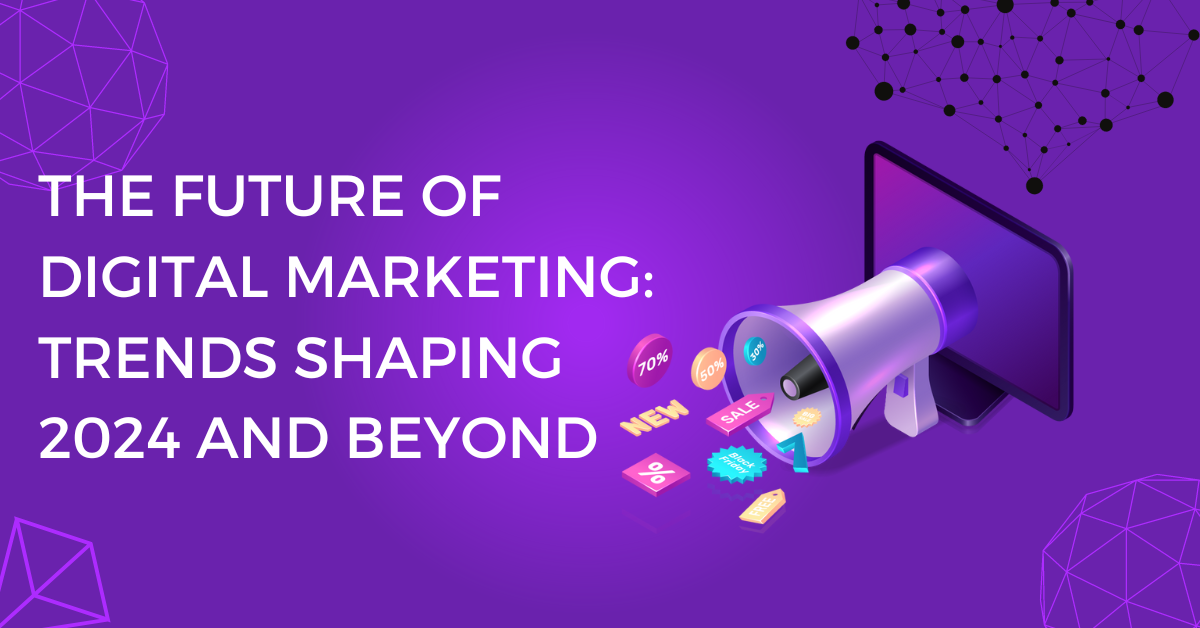In the rapidly evolving digital marketing world, businesses seek innovative strategies to stay ahead. Partnering with a trusted digital marketing agency can be a game-changer, offering local expertise and personalized solutions tailored to the unique dynamics of the Surat market. As we explore the trends shaping the future of digital marketing in 2024 and beyond, it’s essential to recognize the invaluable role a specialized agency in Surat can play in implementing and optimizing these strategies for maximum impact. If you’re in Surat and looking to elevate your digital presence, consider the insights provided here as a foundation and reach out to a reputable agency to transform these trends into tangible results for your business.
1. Artificial Intelligence (AI) and Machine Learning (ML) Integration
One of the most impactful trends in digital marketing is the increasing integration of artificial intelligence and machine learning. AI and ML technologies are revolutionizing the way marketers analyze data, personalize content, and automate tasks. In 2024, we can expect a more widespread adoption of AI-driven tools for customer segmentation, predictive analytics, and personalized content recommendations.
AI in Customer Segmentation
AI enables marketers to create more nuanced and accurate customer segments by analyzing vast amounts of data. This allows for hyper-personalized marketing strategies, ensuring that content and advertisements are tailored to individual preferences and behaviors.
Predictive Analytics for Marketing Strategy
Machine learning algorithms can predict future trends and consumer behaviors based on historical data. Marketers can use predictive analytics to anticipate customer needs, optimize advertising strategies, and allocate resources effectively.
Personalized Content Recommendations
AI-powered recommendation engines are becoming increasingly sophisticated, providing users with personalized content recommendations across various digital platforms. This not only enhances user experience but also boosts engagement and conversion rates.
2. Augmented Reality (AR) and Virtual Reality (VR) Experiences
As technology continues to advance, augmented reality and virtual reality are becoming integral parts of the digital marketing landscape. These immersive technologies offer unique and engaging experiences for consumers, presenting new opportunities for brands to connect with their audiences.
AR for Interactive Advertising
AR allows marketers to create interactive and immersive advertising experiences. For example, customers can use their smartphones to virtually try on products before making a purchase or engage with AR advertisements that respond to their surroundings.
VR for Virtual Shopping
Virtual reality is transforming the e-commerce experience by enabling virtual shopping environments. Customers can explore digital stores, interact with products in 3D, and make informed purchase decisions from the comfort of their homes.
Enhanced Brand Engagement
Brands that incorporate AR and VR into their marketing strategies can differentiate themselves from competitors and provide memorable experiences for their audiences. This enhanced engagement can lead to increased brand loyalty and customer satisfaction.
3. Voice Search Optimization
The rise of voice-activated devices and virtual assistants has fueled the popularity of voice search. Optimizing digital content for voice search is now a critical aspect of effective SEO strategies.
Conversational Content Optimization
Traditional search engine queries differ significantly from voice searches. People tend to use more natural, conversational language when speaking, and marketers need to adapt their content accordingly. Long-tail keywords and a conversational tone become crucial for successful voice search optimization.
Local SEO and Voice Search
A significant portion of voice searches is location-based. Businesses can capitalize on this trend by optimizing their content for local search queries. This includes creating content that addresses local needs, using location-based keywords, and ensuring accurate business information across online platforms.
AI-Powered Voice Assistants
Integrating AI in voice-activated devices makes voice assistants more intelligent and capable of understanding context. Marketers can leverage this by creating content that aligns with the conversational and contextual nature of voice searches.
4. Blockchain for Enhanced Security and Transparency
As concerns about data privacy and transparency continue to rise, blockchain technology is emerging as a solution to address these issues in digital marketing.
Transparent and Secure Transactions
Blockchain ensures transparency and security in digital transactions. Marketers can use blockchain to build trust with consumers by providing a transparent record of transactions, ensuring the authenticity of products, and safeguarding customer data.
Decentralized Ad Networks
Blockchain technology enables the creation of decentralized ad networks, reducing the influence of intermediaries and providing a more direct connection between advertisers and publishers. This streamlines the advertising process and reduces the risk of ad fraud.
Enhanced Data Security
With the increasing emphasis on data protection, blockchain offers a decentralized and secure way to store and manage customer data. This can help marketers comply with data privacy regulations and build trust with their audience.
5. Inclusive and Diverse Marketing Strategies
In 2024, consumers are placing a greater emphasis on inclusivity and diversity. Brands that embrace diversity in their marketing strategies resonate with a broader audience and contribute to positive social change.
Authentic Representation in Marketing
Consumers are becoming more discerning and expect brands to authentically represent diverse perspectives in their marketing campaigns. This includes showcasing diversity in race, gender, age, and lifestyle. Brands that genuinely embrace diversity can build stronger connections with their audience.
Social Responsibility and Purpose-Driven Marketing
Consumers are increasingly supporting brands that align with their values. Companies that engage in social responsibility initiatives and adopt purpose-driven marketing strategies can create a positive brand image and attract socially conscious consumers.
Accessibility in Digital Content
Ensuring that digital content is accessible to individuals with disabilities is a growing priority. Marketers need to consider inclusivity in website design, content formats, and advertising materials to reach a broader audience and demonstrate a commitment to accessibility.
6. 5G Technology and Faster Connectivity
The rollout of 5G technology is set to revolutionize the digital landscape, providing faster and more reliable connectivity. This has implications for mobile marketing, user experience, and the integration of emerging technologies.
Enhanced Mobile Experiences
With 5G, mobile devices can deliver richer and more immersive experiences, including high-quality video streaming, augmented reality applications, and faster-loading websites. Marketers should optimize their content for mobile platforms to leverage the capabilities of 5G technology.
Internet of Things (IoT) Integration
5G facilitates the seamless integration of IoT devices, creating a more interconnected digital ecosystem. Marketers can leverage data from connected devices to understand consumer behavior, deliver personalized experiences, and optimize their marketing strategies.
Real-Time Interactivity
The low latency of 5G enables real-time interactivity in digital experiences. Live streaming, interactive content, and instant communication become more feasible, allowing marketers to engage with their audience in new and innovative ways.
7. Privacy-First Marketing
With increased scrutiny on data privacy and the implementation of stricter regulations, privacy-first marketing practices are gaining prominence.
User Consent and Transparency
Marketers need to prioritize obtaining user consent for data collection and clearly communicate how customer data will be used. Transparency builds trust, and businesses that are upfront about their data practices are more likely to establish positive relationships with their audience.
Cookie-Free Tracking Solutions
As browser updates and privacy regulations limit the effectiveness of traditional cookies, marketers are exploring alternative tracking solutions. Technologies like fingerprinting and AI-driven analytics are becoming more prevalent, allowing for effective tracking without relying on cookies.
Data Minimization and Protection
Privacy-first marketing involves collecting only the necessary data and implementing robust security measures to protect customer information. Marketers should regularly audit their data practices to ensure compliance with privacy regulations and reassure customers about the safety of their data.
8. Video Content Dominance
The popularity of video content continues to rise, with platforms like YouTube, TikTok, and Instagram dominating the digital landscape. In 2024, video will remain a powerful tool for capturing audience attention and conveying brand messages.
Short-Form Video Content
Short-form videos, especially on platforms like TikTok, have become immensely popular among younger audiences. Marketers can leverage this trend by creating engaging and shareable short-form video content that aligns with their brand identity.
Live Streaming for Authenticity
Live streaming provides an authentic and real-time connection with audiences. Whether it’s behind-the-scenes looks, product launches, or interactive Q&A sessions, live streaming allows brands to humanize their presence and engage with customers on a personal level.
Interactive and Shoppable Videos
Interactive and shoppable videos enable a seamless transition from content consumption to product purchase. Viewers can engage with the video, explore product details, and make purchases without leaving the platform. This convergence of content and commerce enhances the customer journey and drives conversions.
Conclusion
As we conclude this exploration of the future trends shaping digital marketing in 2024 and beyond, it’s evident that staying ahead in the dynamic online landscape requires strategic partnerships. Consider collaborating with a reputable digital marketing company to harness the full potential of these trends for your business. This local expertise can make a substantial difference in implementing personalized and effective digital strategies. If you’re in Surat and ready to take your digital presence to new heights, reach out to a trusted company to transform these insights into actionable plans, ensuring your business thrives in the evolving world of digital marketing.
The post The Future of Digital Marketing: Trends Shaping 2024 and Beyond appeared first on Datafloq.



